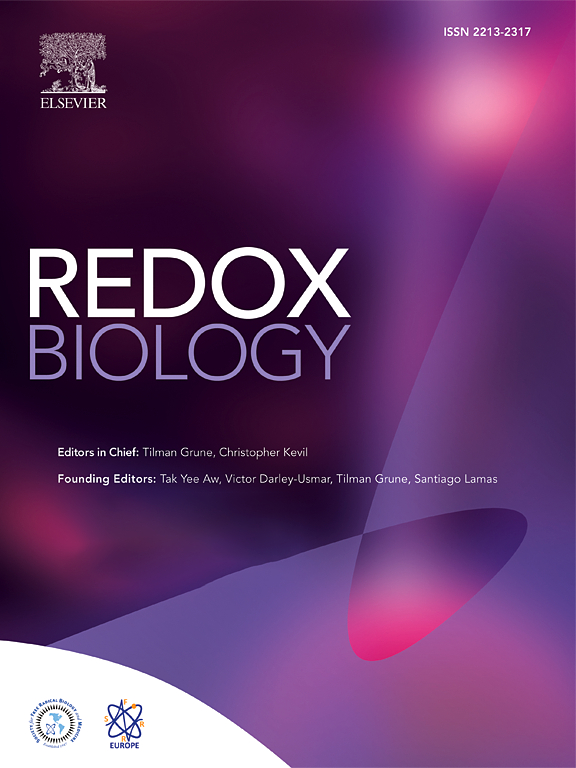在帕金森病模型中,α-突触核蛋白与 ACO2 的结合会促进线粒体功能的进行性障碍。
IF 10.7
1区 生物学
Q1 BIOCHEMISTRY & MOLECULAR BIOLOGY
引用次数: 0
摘要
α-突触核蛋白(α-syn)是帕金森病(PD)中的一种关键蛋白质,它的积累会导致线粒体功能障碍以及与各种蛋白质相互作用相关的渐进性神经元损伤。然而,α-syn影响能量代谢的确切机制仍不清楚。在我们的研究中,我们使用了表现出进行性神经元衰退的人类α-syn(hα-syn)转基因小鼠。通过对 hα-syn 的特异性免疫沉淀分析,我们发现线粒体三羧酸(TCA)循环中的一种酶是结合伙伴--线粒体丙酮酸酶 2(ACO2),它能将柠檬酸转化为异柠檬酸。随着小鼠年龄的增长,Hα-syn 与线粒体中 ACO2 的相互作用越来越密切,这与 ACO2 活性的逐渐降低有关。据观察,过量表达 ACO2 和添加 ACO2 的下游代谢产物异柠檬酸盐可减轻 Hα-syn 诱导的线粒体功能障碍和细胞毒性。此外,我们还设计了一种干扰肽来阻断 ACO2 与 hα-syn 之间的相互作用,该干扰肽在体外和体内均显示出降低 hα-syn 毒性的治疗效果。我们的研究建立了α-syn与TCA循环之间的直接联系,并将ACO2确定为改善线粒体功能和降低α-syn对帕金森病神经毒性的治疗靶点。本文章由计算机程序翻译,如有差异,请以英文原文为准。
Binding of α-synuclein to ACO2 promotes progressive mitochondrial dysfunction in Parkinson's disease models
The accumulation of α-synuclein (α-syn), a key protein in Parkinson's disease (PD), contributes to progressive neuronal damage associated with mitochondrial dysfunction and interactions with various proteins. However, the precise mechanism by which α-syn affects energy metabolism remains unclear. In our study, we used human α-syn (hα-syn) transgenic mice, which exhibit progressive neuronal decline. Through an immunoprecipitation assay specific to hα-syn, we identified an enzyme in the mitochondrial tricarboxylic acid (TCA) cycle as a binding partner—mitochondrial aconitase 2 (ACO2), which converts citrate to isocitrate. Hα-syn increasingly interacted with ACO2 in mitochondria as mice aged, correlating with a progressive decrease in ACO2 activity. The overexpression of ACO2 and the addition of isocitrate, a downstream metabolite of ACO2, were observed to alleviate hα-syn-induced mitochondrial dysfunction and cytotoxicity. Furthermore, we designed an interfering peptide to block the interaction between ACO2 and hα-syn, which showed therapeutic effects in reducing hα-syn toxicity in vitro and in vivo. Our research establishes a direct link between α-syn and the TCA cycle and identifies ACO2 as a promising therapeutic target for improving mitochondrial function and reducing α-syn neurotoxicity in PD.
求助全文
通过发布文献求助,成功后即可免费获取论文全文。
去求助
来源期刊

Redox Biology
BIOCHEMISTRY & MOLECULAR BIOLOGY-
CiteScore
19.90
自引率
3.50%
发文量
318
审稿时长
25 days
期刊介绍:
Redox Biology is the official journal of the Society for Redox Biology and Medicine and the Society for Free Radical Research-Europe. It is also affiliated with the International Society for Free Radical Research (SFRRI). This journal serves as a platform for publishing pioneering research, innovative methods, and comprehensive review articles in the field of redox biology, encompassing both health and disease.
Redox Biology welcomes various forms of contributions, including research articles (short or full communications), methods, mini-reviews, and commentaries. Through its diverse range of published content, Redox Biology aims to foster advancements and insights in the understanding of redox biology and its implications.
 求助内容:
求助内容: 应助结果提醒方式:
应助结果提醒方式:


